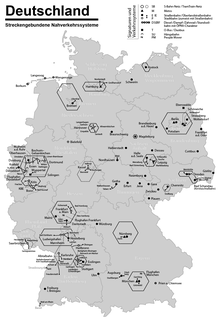
Germany has an extensive number of tramway networks (Straßenbahn in German (German: [ˈʃtʁaːsn̩ˌbaːn] )). Some of these networks have been upgraded to light rail standards, called Stadtbahn in German. Straßenbahn and Stadtbahn schemes are usually operated on the legal foundation of the BOStrab, the Tramways Act of Germany.
Tramways served as the primary means of urban transport in Germany until the early 1960s when they were systematically replaced by buses. However, in the 1980s tramways began to reappear; experts spoke of the 'renaissance of the tramway'. In the 1990s tramways had again become a modern means of public transport. Popular notions of fashion have been used by scholars to explain this cycle of acceptance rejection and restoration. Tramways were a highly visible manifestation of commodity culture and people projected onto them not just travel destinations but more broadly their desires, ideas and beliefs.[1]
- ^ Barbara Schmucki, "Fashion and technological change: Tramways in Germany after 1945." The Journal of Transport History 31.1 (2010): 1-24.